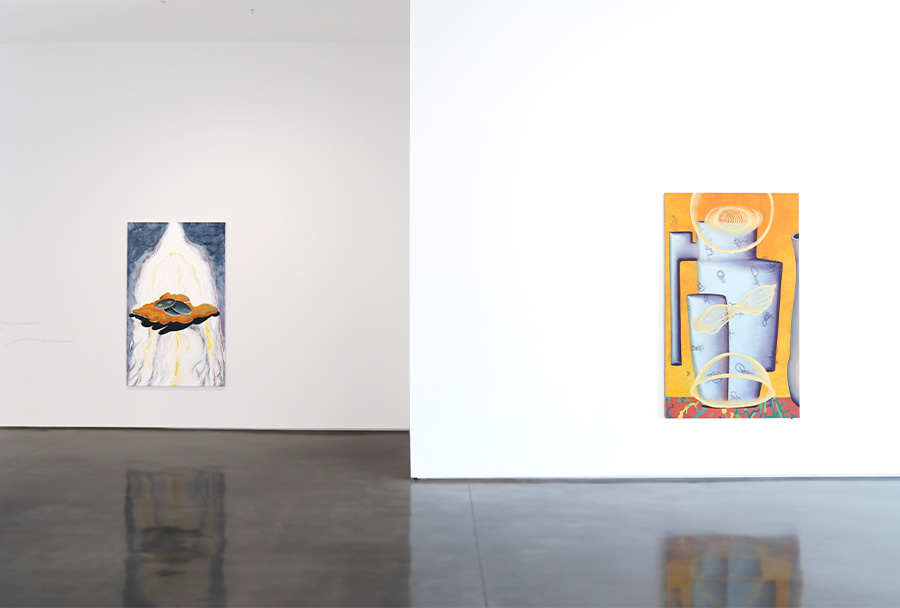
Titania Seidl Solo Exhibition| press release
Exhibition Opening: 11/8/2024, 8 p.m.
Exhibition Duration: 11/8/2024-7/10/2024
Address: Arch Gallery, 1/F, 1123 Cultural and Creative Park, Tianxin District, Changsha, China
Arch Gallery is honored to announce the fifirst solo exhibition of Austrian artist Titania Seidl, titled "Some of the Places We Take Each Other," following her addition to the gallery's roster of represented artists. This exhibition features 24 paintings that weave together various themes that the artist has been exploring, offffering a comprehensive overview of Seidl's artistic practice over the past decade.
"Painting was the only place I could take myself," a quote from artist Miyoko Ito during an interview, has profoundly inflfluenced Titania Seidl, who possesses extensive knowledge in art history, literature, and social sciences. Seidl believes this statement dissolves the boundary between subject and object, opening up a new realm of imagination that manifests itself in her painting practice. This exhibition aims to open a multifaceted door to historical fragments and modern imagination, allowing viewers to fifind themselves reflflected in the works.
The exhibition title can be interpreted in more than one way: The fifirst layer of "place" can be understood physically, where difffferent themes within the exhibition space create distinct environments, immersing the audience in new settings with each exhibit. Beyond this, "place" is also non-physical, encouraging viewers to move beyond purely formal elements like lines and colors. The artist hopes to offffer new ways of thinking and viewing, opening the door to new stages of understanding and sensation.
Historical Fragments and Modern Reflflection
As a native European artist, Titania Seidl is inevitably inflfluenced by both classical painting and contemporary visuals. Interacting with history is often part of daily life, with traces of great eras scattered across bustling streets—one corner may host Roman ruins, another a Baroque palace, flflanked by Art Deco buildings and a neo-Gothic cathedral. These encounters with historical fragments deepen her understanding of our current era, leading her to believe that any historical image is inherently incomplete and fragmented. This resonates with Walter Benjamin’s concept of "Jetztzeit" or "now-time," which highlights the discontinuity and heterogeneity of history, prompting artists to reconstruct their understanding of it. Consequently, Seidl prefers to use magnifified details, marginal materials, and seemingly insignifificant elements in her creations to reflflect her experience of history. The artist is fascinated by the recontextualization of "non-artistic" images, such as 19thcentury botanical watercolors initially created for scientifific research and knowledge dissemination, rather than for artistic visual experience. In her works, these images are placed within the context of modern art and juxtaposed with other elements to create new visual relationships. She is intrigued by "non-artistic images," those not regarded as art but as tools or vessels of knowledge. Using scientifific botanical illustrations that show multiple stages of a subject, she creates works that embody characteristics of "non-artistic" images.
Defamiliarization and Unity of Images
Viktor Shklovsky's "defamiliarization" effffect, which aims to make people feel the essence of things rather than merely recognize them, is evident in Seidl's exploration of the relationships between difffferent elements. These include the representation of historical images, the contrast of colors, and the unrestricted arrangement of elements. Through defamiliarization, she encourages viewers to reassess and feel these elements and their interrelationships, presenting historical elements in a modern context with a fresh appearance.
Skepticism of Image Authenticity
The grandeur of Baroque churches in Vienna, with their trompe l'oeil painted ceilings, has left a lasting impression on Seidl. In today's digital age, where image manipulation is common, the pursuit of realistic representation in art has diminished. The artist's skepticism of image authenticity leads her to question the function of painting in an era where artifificial intelligence generates visual content. Her work oscillates between the fifigurative and the abstract, creating new image relationships that defy conventional norms. By challenging the habitual constraints of collective experience and realism, she reminds viewers to question the authenticity of the images they see.
Seidl's multifaceted roles as an artist, writer and curator over the past decade have enabled her to develop an art practice with a rich theoretical foundation and social concern. Her works offffer multiple entry points for viewing, establishing interrelationships between scenes, texts, and personal symbols. This approach transfers the agency of interpreting images to the viewer, breaking down barriers to viewing. The dispersed images and flfloating texts in her paintings invite various combinations and new narratives, continually expanding the imaginative space for viewers.

